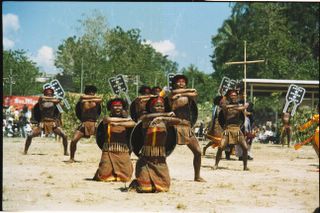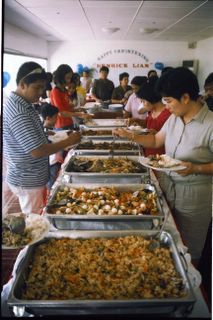
Maradjaw Karadjaw dance depicting the christianisation of the
Mamanuas (natives) of Surigao during annual Bonok-bonok Festival.
It took me a long time and some head-splitting web-browsing to figure out the geo-political make-up of Chesterfield and Surigao (and SurNorte). Browsing the websites of my Surigao is like eating bihon with fork: twirling the noodles hoping the cook didn't forget to add some meat for flavor. There were a lot of facts, a lot in fact that after clicking the x button at the upper-right hand side of my window, I only realized that the site is not really meant for me, or for any Surigaonon, or for any ordinary Filipino, but for investors. Business people. Capitalists. Or foreigners, as locals generally call them. The mayor, in his Message on the site, said that "Our place offers you the best options for business, leisure and travel." and that "Surigao is one of the "Peace Cities" of the world and one of the Asia’s most livable cities."
I don't want to comment on that one, nor of the rest of the content of the website because it just reminds me of brochures, after all there is a link that tells whoever is visiting the site of their contact details. One thing the visitor will know and remember for sure is the face of the mayor and the governor.
Why I did this information-search in the first place is to attempt to do some comparisons of the two places although I know how illogical it sounds and how impossible it is. The composition of political units is spanish-american. There is no equivalent of borough and district or if there is, the meaning is totally different. However, I did some calculations with some help from K, B, and the online metric conversion and I hope I got these results right:
Surigao City: population density = 59 persons per hectare
Chesterfield: population density = 15 persons per hectare
a) All people from the barangays transferred to the city;
b) Women are prolific;
c) No wonder why there's always lots of people at the pier;
d) Four church masses every Sunday and additional twice daily is proof of overcrowding;
e) Flying voters are documented;
f) This is justification for the one-street-route-of-multicabs policy;
g) Additional trysikad and tricycles are necessary; or
h) I just got my calculations wrong; it should be the other way around.
Whatever it is, it makes the city alive and bustling. It makes it more exciting to go to Jollibee or Greenwich (I heared that there's another fastfood chain that just came up) and sit by the glass wall and be seen from outside. It makes it more fun to just sit by and watch people cross pedestrian lanes with on-the-face reminder of Php25.00 fine (or is it now Php50.00 pesos?) when crossing when red light is still on. It makes it more mouth-watering when at the end of a long hot day, everybody decides to go to the pier to eat the best ever saucy chicken barbeque at Carmen's or to the pantalan to have tinuya and kinilaw instead.
I have learned to love Chesterfield and enjoy two of its pubs but I still think of Surigao--and miss it, despite the content of its website.

